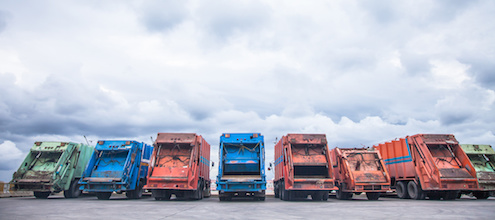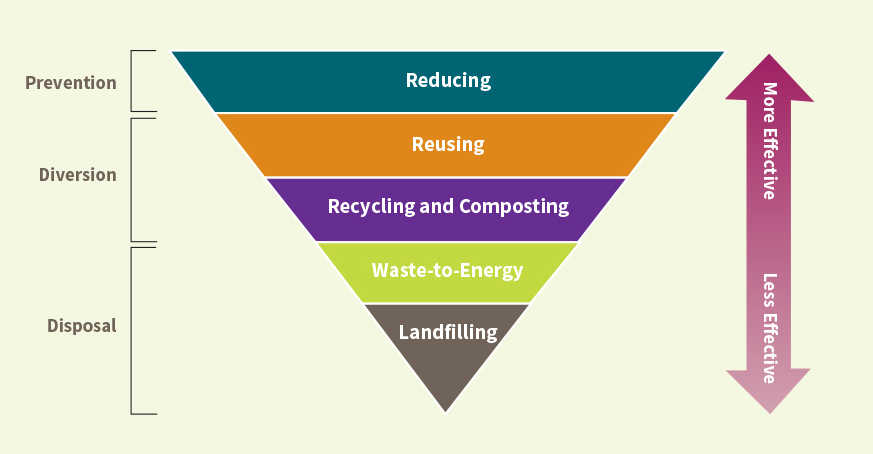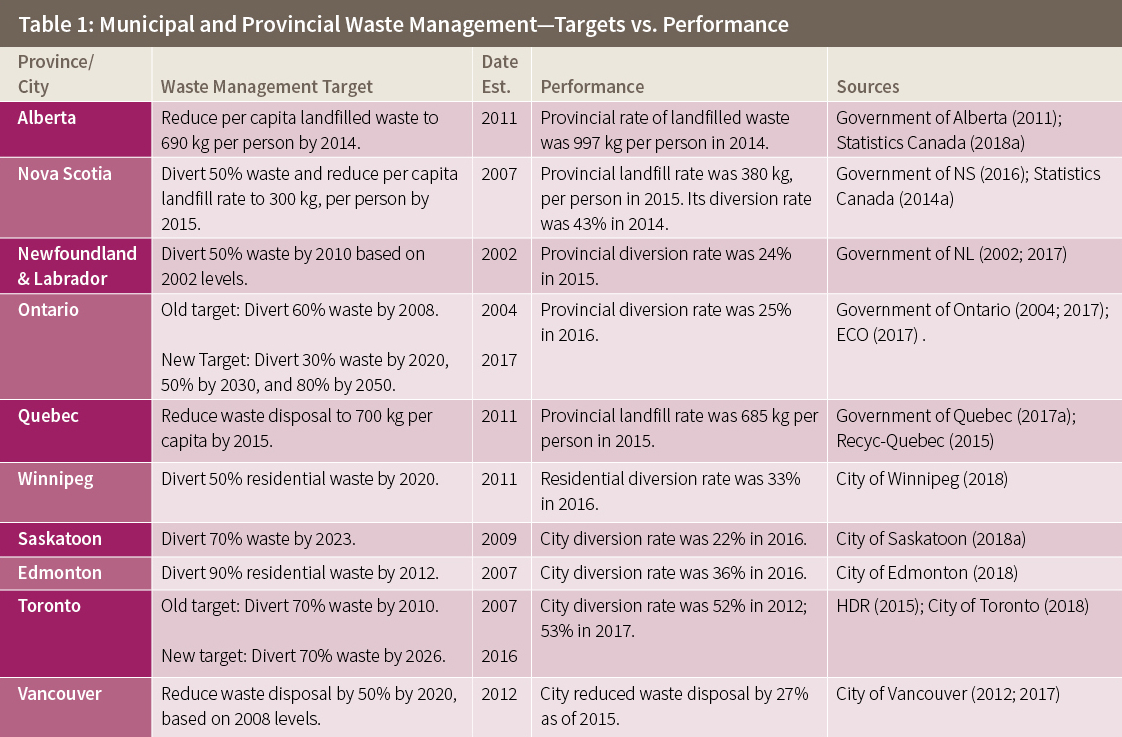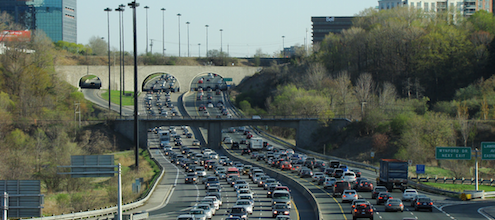
A waste opportunity: Canada can—and should—make its solid waste systems more efficient
Garbage might be stinky, but it offers a refreshing source of common ground. We can all agree that generating less garbage is a good thing. We can also probably agree that we should manage our garbage in ways that reduce health and environmental risks to our communities.
When it comes to managing our solid waste, however, Canada can clearly do better. Ecofiscal’s newest report, entitled Cutting the Waste, finds that making our waste systems more efficient can save money for municipalities and taxpayers. The key is smart policy that creates better incentives for manufacturers and consumers.
This is the first blog of our new series on solid waste management. It sets the stage by looking at the challenges and opportunities with solid waste management in Canada.
Our mounting piles of trash
There’s no getting around it: Canada has a problem with solid waste. On average, Canadians generate nearly twice as much waste as other high-income countries. In 2016, for example, we generated about 34 million tonnes of solid waste, or just under one tonne for every person. Canadians make up 0.5% of the world’s population yet produce about 2% of its municipal solid waste.
Canada also scores poorly on waste diversion and prevention. Progress is different across communities, but we still bury three-quarters of our waste in landfills. Gradual improvements in recycling and composting have helped; however, governments continue to fall short on their waste diversion targets (see table).
More waste = More costs
The more waste we generate, the costlier it becomes—particularly for municipalities and taxpayers that fund these services. The amount of residential garbage in Canada increased by 18% between 2002 and 2014, while total public expenditures to manage this waste increased by 115%. Landfills are expensive to build and operate and over one-third of Canadian landfills are at or near capacity. Many communities are already reckoning with costly alternatives.
Landfills also impose environmental costs. Foul odours, traffic, and other environmental risks can depress property values for nearby residents (who wants a landfill near their backyard?). More landfills also mean more GHG emissions: landfills account for 20% of Canada’s methane emissions, a potent greenhouse gas.
Waste disposal is costly, but so are the alternatives. Facilities that manage our compost and recycling are expensive to build and operate, as are the programs that collect them from the curb. There are also limits to how much solid waste consumers and producers are willing or able to eliminate through waste prevention.
No matter how you look at it, there’s no free lunch in waste management. So, how can communities keep providing these essential services while keeping costs down?
Going beyond “the waste hierarchy”
The waste hierarchy (shown below) has been instrumental in shaping how governments think about the problems and solutions associated with waste management. The “reduce, reuse, recycle” heuristic, for example, is an ingrained part of our policy and political discourse. Municipal and provincial waste targets are also rooted in these principles, including the current push for “zero waste.”

Despite its profound influence, however, the waste hierarchy paints an incomplete picture. It tells us little about the complex trade-offs associated with moving up (or down) the hierarchy. Landfilling all our waste isn’t ideal, but neither is trying to divert or prevent all of our waste. In both cases, the costs would outweigh the benefits. We need a broader, more comprehensive objective for how we manage our waste.
Governments should improve the efficiency of waste management systems
Our report argues that governments should take a wider view and aim to improve the overall efficiency of our waste management systems.
Improving system efficiency is fundamentally about considering the full range of costs and benefits associated with different policies—both financial and environmental. It’s about choosing policies that minimize costs, while maximizing benefits. It’s about striking a better balance between waste disposal, diversion, and prevention. Moving up the waste hierarchy is not necessarily the most economically efficient way to manage waste, even though in some—or most—cases it might be.
Admittedly, system efficiency is a more complex objective than simply moving up the hierarchy. After all, there’s no single model of an efficient waste-management system: every community is different.
Yet improving system efficiency does not always have to be more complicated. Markets are generally very good at efficiently allocating resources, particularly when the cost of something reflects its true cost. If our waste systems could operate more like well-functioning markets, the resulting decisions of households and businesses can move us closer to a more efficient balance between waste disposal, diversion, and prevention.
Six distinct—but interrelated—problems make our waste systems inefficient
As we find in our report, however, waste-management markets are not normal, well-functioning markets. Prices—where they exist—do not typically reflect the full costs and benefits associated with waste-management services and materials.
Our report identifies six interconnected problems that cascade throughout solid-waste markets. Each of these issues make waste-management systems inefficient. (Click on the tabs below for a quick explainer):
Households typically pay for waste collection through property taxes or monthly fees. In other words, the amount residents or businesses pay for waste management has—in many cases—no connection with the quantity or composition of solid waste they generate.
As a result, households tend to generate and dispose more solid waste than they otherwise would if they paid directly for the service. Low waste-disposal prices also weaken the incentive to divert waste through recycling or composting.
Waste-disposal prices are more transparent for the commercial sector, including businesses, large buildings, institutions, and industry. Commercial waste is typically hauled directly to landfills, where waste generators pay a fee to dump their waste based on the weight or type of waste being tipped.
In many cases in Canada, however, the fee for disposing every tonne of garbage is less than the full cost, encouraging waste generators to landfill more waste than they would otherwise. Fees in Canada often do not reflect the long-term costs of landfilling—that is, the future costs of building new landfill sites when existing ones reach capacity. Similarly, fees often exclude some of the social costs of landfilling, such as environmental risks to water and soil, GHG emissions, and impacts on local property values due to odour and unsightliness.
The boundaries of solid waste-management systems are porous. Unlike municipal water and wastewater systems, where municipalities have near complete control over treatment and distribution infrastructure, solid-waste systems—and the flows of waste within them—are more decentralized. These porous boundaries can make it difficult for municipalities to charge the full cost of waste disposal, as it can encourage waste to be exported to jurisdictions with lower tipping fees.
While waste exports aren’t necessarily a problem in and of themselves, they can undermine a municipality’s ability to recover its costs. Building, maintaining, and closing landfills is capital intensive, meaning that a large portion of disposal costs is fixed. When waste exports increase, municipalities generate less revenue to cover these costs. Waste exports can also undermine environmental outcomes if waste is exported to landfills that are less secure or to systems that put less emphasis on waste diversion and resource recovery.
Even if communities address issues #1 to #3 and charge the full cost of waste disposal, the private sector would not necessarily provide adequate diversion alternatives. Collection and management systems for diversion often make financial sense only when operated on a broader scale. Achieving this scale can be difficult, particularly in small, rural, and northern communities.
Persistently high contamination rates may also stymie waste diversion opportunities. Service providers have limited control over how waste is sorted before they collect it, relying on households and businesses to separate their waste correctly. But despite better education and awareness, contamination rates are as high as 25% in some communities, which increases processing costs and reduces the value of diverted materials. Tighter restrictions imposed by China have amplified these problems and made recycling markets more unpredictable, leading many companies to shut down across North America.
If waste-management services were priced according to their full cost—in all jurisdictions—consumers would have clear incentives to purchase goods made with less packaging or from materials that are easier to recycle. Producers, in turn, would have incentives to design and manufacture goods that generate less waste.
But even if individual municipalities charged residents directly for waste disposal, and even if these prices approached the full net cost of the service, prices would have a negligible impact on upstream production. Waste is priced locally, and Canada may be too small to affect global manufacturers.
The majority of consumer goods produced in the economy use virgin materials, extracted and processed from the natural environment. These processes, however, can cause significant environmental damages that are unpriced or underpriced in markets. This effectively subsidizes the use of virgin materials and distorts markets further downstream for recycling, reuse, and prevention. Firms have an incentive to use more virgin materials and fewer recycled and reused materials in their manufacturing processes.
Ultimately, smart policy can provide better incentives to consumers and manufacturers
The challenges facing our solid waste management systems are complex. But the six problems provide a roadmap for how governments can make them more efficient. Doing so can reduce the costs for municipalities, taxpayers, and businesses.
As we’ll see in future blogs, efficient waste management starts with creating better incentives for households and businesses. Policies like “pay-as-you-throw” (PAYT) for residential garbage collection and user fees or “tipping fees” at landfills can reinforce the link between how much waste we generate and how much we pay.
Critically, making our waste systems more efficient also requires going further up the supply chain. In many cases, manufacturers download the costs of waste management onto municipalities and taxpayers. Policies like “extended producer responsibility programs” can turn this around by making manufacturers physically and financially responsible for managing the waste from their products. Just like with PAYT programs and tipping fees, EPR programs can create incentives to reduce how much waste we produce.
Ultimately, the case for improving our waste management systems is an economic one. Creating better financial incentives can improve the efficiency of our systems, reducing costs and increasing benefits for municipalities, taxpayers, and the environment. It may be smelly and gross, but improving how we manage our trash is an opportunity that can’t be wasted.
Download the Report (PDF)




Comments are closed.